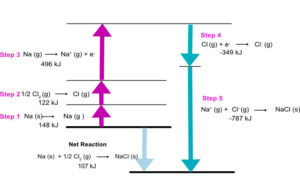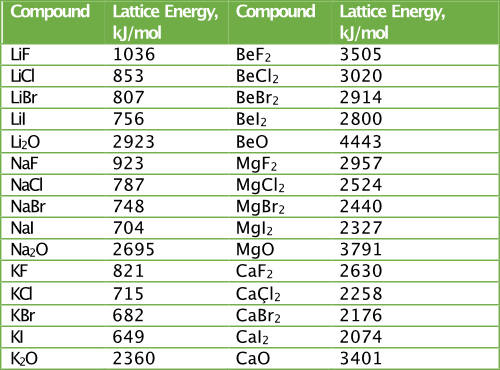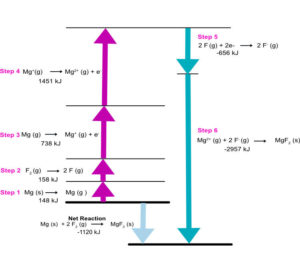Lattice energy, Elattice is the energy required to separate one mole of a solid ionic compound into its gaseous ions. The lattice energy for NaCl is:
The process absorbs energy, and is highly endothermic. The equation for the lattice energy is the reverse of the equation in Step 5 in the figure below, for the formation of the solid from its ions which releases 787 kJ/mol of energy.
A Born-Haber cycle allows the calculation of the lattice energy for a solid ionic compound. The lattice energy is always positive, because it takes energy to separate the ions from the solid.
Lattice energy, Elattice is dependent on the strength of the bond between the cation and anion in an ionic bond. The stronger the bond, the higher the lattice energy. Recall, lattice energy is positive meaning it is endothermic. Energy is required. Coulomb’s law is equal to a constant, k, multiplied by the product of the ion charges, z1 and z22, between the ions. Coulombs Law is:
Recall, that energy is equal to the force multiplied by the distance, E = F x d.
Lattice energies are large when ions are closer together, the distance between the ions is small and when the charges are larger. For example, the lattice energy of NaCl is larger than the lattice energy of KCl. This is because the charges are the same, but the potassium ion is larger than the sodium ion. In the case of NaCl and MgCl2, the MgCl2 has the larger lattice energy because the magnesium cation is smaller, and the charge is a +2 rather than a +1 for the sodium ion.
Below is a table with the lattice energies of some ionic compounds. A more extensive list can be found in other tables or in the Handbook of Physics and Chemistry.
Worksheet: Ionic Compounds, Born-Haber Cycle, and Lattice Energy
Worksheet: Periodic Trends
Exercises
Exercise 1. Consider the following Born-Haber cycle for MgF2. What is the lattice energy for MgF2?
Exercise 2. Order the following ionic compounds from lowest to highest lattice energy. MgBr2, SrBr2, CaBr2
Exercise 3. Which has the highest lattice energy, Na3P or Na2S?
Exercise 4. Calculate the lattice energy for SrCl2. The sublimation energy for Sr is 164 kJ/mol, Ei1 = +549.5 kJ/mol, Ei2 = +1064.2 kJ/mol, Eea for Cl (g) = -348.6 kJ/mol, energy for the formation of one mole of SrCl2 from its elements = -803.7 kJ/mol, and the bond dissociation energy for Cl2 (g) = +243 kJ/mol.
Exercise 5. Calculate the lattice energy for CaF2.
Esublimation for Ca (s) = 178.2 kJ/mol
Ei1 = +589.8 kJ/mol
Ei2 = +1145 kJ/mol
Eea = -328 kJ/mol
DF2 = +158 kJ/mol
Energy of formation for one mole of CaF2 from its elements = -1228 kJ/mol
Check Solutions/Answers to Exercises
Back to Periodic Trends and Ionic Compounds
Back to General Chemistry 1 Study Guides
Back to Home Page



